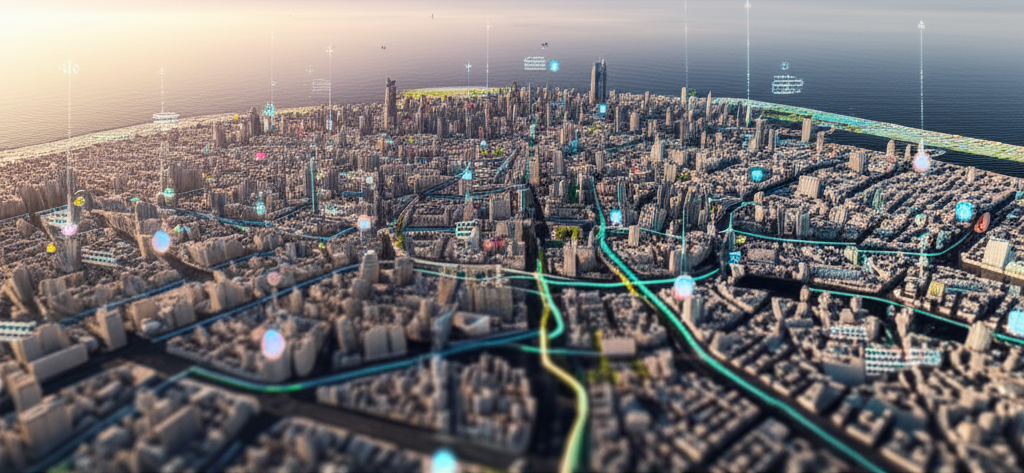How virtual replicas of physical assets are transforming how we build, manage, and optimize infrastructure.
Digital Twins: Revolutionizing Infrastructure Management and Urban Planning Section
Digital twins—virtual replicas of physical assets, systems, or processes—are transforming how we design, build, and manage infrastructure. By creating detailed digital models that continuously update with real-time data, organizations can simulate, analyze, and optimize their physical counterparts with unprecedented precision.
Understanding Digital Twins
A digital twin is more than just a 3D model or simulation. It's a living digital representation that:
- Mirrors the physical state of an asset or system in real-time
- Incorporates IoT sensor data, historical information, and human expertise
- Enables monitoring, analysis, prediction, and optimization
- Evolves throughout the lifecycle of the physical asset
"Digital twins represent the convergence of our physical and digital worlds," explains Tyler Hill, CEO of SecLevelAlpha. "They allow us to understand, interact with, and improve our built environment in ways that weren't possible before."
Applications in Infrastructure Management
Smart Buildings
Digital twins are revolutionizing how buildings are designed, constructed, and operated:
- Design optimization: Simulating different designs to maximize energy efficiency, occupant comfort, and space utilization
- Construction management: Tracking progress, identifying potential issues, and optimizing schedules
- Facilities management: Monitoring building systems, predicting maintenance needs, and optimizing energy usage
- Occupant experience: Analyzing space utilization and environmental conditions to improve comfort and productivity
Transportation Networks
Transportation agencies are using digital twins to:
- Model traffic patterns and optimize signal timing
- Predict maintenance needs for roads, bridges, and tunnels
- Simulate the impact of new infrastructure or policy changes
- Optimize public transit routes and schedules
Utility Networks
Water, power, and telecommunications companies leverage digital twins to:
- Monitor network performance and identify inefficiencies
- Detect leaks, outages, or other issues before they become critical
- Optimize resource distribution based on demand patterns
- Plan infrastructure upgrades and expansions
Digital Twins for Urban Planning
Beyond individual assets, digital twins are being applied at the city scale to:
- Simulate the impact of new developments on traffic, utilities, and public services
- Model climate change scenarios and develop resilience strategies
- Optimize energy usage across multiple systems
- Improve emergency response planning and execution
Key Technologies Enabling Digital Twins
Several technologies are converging to make digital twins increasingly powerful:
Internet of Things (IoT)
Networks of sensors provide the real-time data that keeps digital twins synchronized with their physical counterparts. These sensors can monitor:
- Structural integrity
- Environmental conditions
- Occupancy and usage patterns
- Energy consumption
- Equipment performance
Artificial Intelligence and Machine Learning
AI and ML algorithms help digital twins:
- Identify patterns and anomalies in data
- Predict future conditions and potential failures
- Optimize operations based on multiple variables
- Improve accuracy over time through continuous learning
Extended Reality (XR)
Virtual, augmented, and mixed reality technologies allow users to:
- Visualize digital twins in immersive 3D environments
- Interact with digital twins in intuitive ways
- Overlay digital information on physical assets
- Collaborate with others in shared virtual spaces
Implementation Challenges
Despite their potential, implementing digital twins comes with several challenges:
Data Integration
Digital twins require data from multiple sources, often in different formats and with varying levels of quality. Organizations must develop strategies for:
- Standardizing data formats
- Ensuring data quality and reliability
- Integrating legacy systems with new IoT platforms
- Managing data privacy and security
Organizational Change
Successful implementation requires changes in how organizations operate:
- Breaking down silos between departments
- Developing new skills and capabilities
- Establishing new processes and workflows
- Creating a culture that values data-driven decision making
Technical Complexity
Building and maintaining digital twins requires:
- Specialized expertise in modeling, simulation, and data science
- Robust IT infrastructure to handle large volumes of data
- Interoperability between different systems and platforms
- Ongoing maintenance and updates as physical assets change
The Future of Digital Twins
As technology continues to advance, we can expect digital twins to become:
- More comprehensive, covering entire cities and regions
- More autonomous, with AI making routine decisions without human intervention
- More predictive, anticipating issues before they occur
- More accessible, with user-friendly interfaces for non-technical users
Getting Started with Digital Twins
For organizations looking to implement digital twins, we recommend a phased approach:
- Start small: Begin with a single asset or system that has clear potential for improvement
- Focus on value: Identify specific business outcomes that the digital twin will help achieve
- Build incrementally: Add complexity and functionality over time as you demonstrate value
- Collaborate across disciplines: Bring together domain experts, data scientists, and IT professionals
- Plan for scale: Design your initial implementation with future expansion in mind
"The organizations that will benefit most from digital twins are those that view them not just as a technology project, but as a new way of thinking about their physical assets," says Tyler Hill. "It's about creating a continuous feedback loop between the physical and digital worlds that drives ongoing improvement."
Conclusion
Digital twins represent a fundamental shift in how we interact with our built environment. By creating virtual replicas that continuously update with real-time data, organizations can monitor, analyze, predict, and optimize their physical assets with unprecedented precision.
While implementing digital twins comes with challenges, the potential benefits—improved efficiency, reduced costs, enhanced sustainability, and better decision-making—make them an essential tool for infrastructure management and urban planning in the 21st century.
At SecLevelAlpha, we're helping organizations across industries implement digital twins that deliver tangible business value. Whether you're managing buildings, transportation networks, utilities, or entire cities, digital twins can help you make better decisions, reduce costs, and improve outcomes for the people you serve.
Tyler Hill
Contributor at SecLevelAlpha



